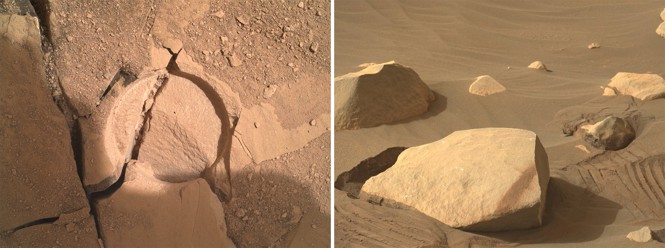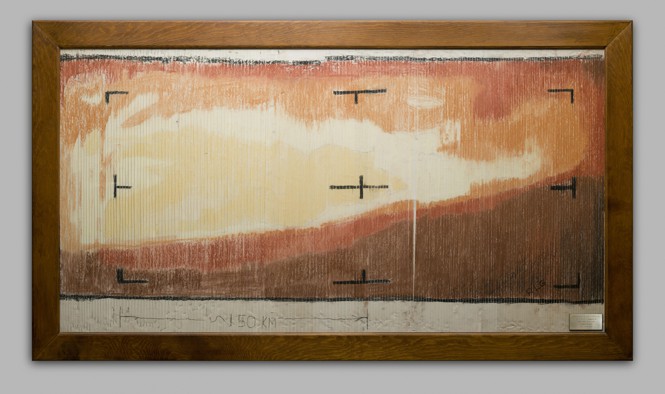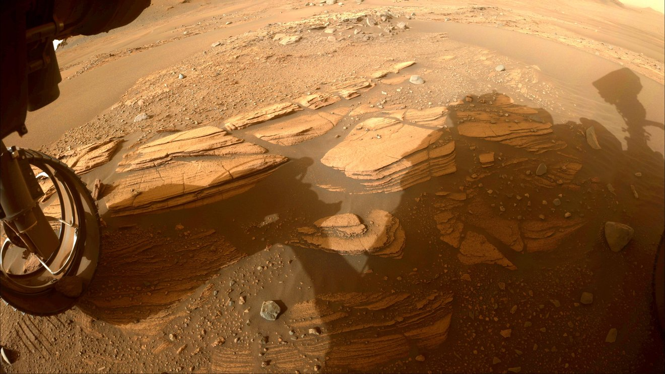
When Corrine Rojas comes into work, Mars is waiting for her. She drives to the office, grabs a cup of coffee, and then pulls up the latest dispatches from Perseverance, a car-size NASA rover situated inside a crater in Mars’s northern hemisphere. Rojas, an operations engineer at Arizona State University, checks that the rover’s main cameras are working well, and that they took the shots scientists back home had asked for. Then, she basks in the wondrous sights of our celestial neighbor. “I am often the first person to lay eyes on photos from Mars taken by the rover,” Rojas told me.
And Mars has been looking particularly good lately. That’s not to say that the planet has been working on its appearance; aside from the winds blowing around some dust, it has remained mostly unchanged for a few billion years. The difference is us, and particularly the Perseverance mission, which has captured some of the sharpest views of the Martian surface to date. The rover’s job is to search for potential signs of fossilized life in the rock, but since it arrived last February, it has become quite the landscape photographer.
In more detail than ever before, we can see that the red planet’s rocky outcroppings are bursting with texture, layer after layer. The soft, muted browns and oranges of the terrain look remarkably vivid. The soil looks almost silky. In our night sky, Mars is nothing more than a gleaming tangerine speck. In Perseverance’s pictures, it looks like not only a real planet but also a real place. It’s one thing to look at a zoomed-out shot of Mars as a perfect sphere against the darkness of space. It’s quite another to gaze upon something you could easily imagine finding on a Tripadvisor page about the best state parks in Arizona.

“You just want to go hiking in that environment,” says Jim Bell, a planetary scientist at Arizona State University who leads the camera team Rojas works on. “Bring some water; bring some oxygen.” Mars would actually be a terrible place to hike, let alone live. “In reality, the place would be trying to kill us in so many ways,” Bell told me. But the pictures are still swoon-worthy.
[Read: Mars’s soundscape is strangely beautiful]
Scientists and engineers have come a long way from the earliest attempts to capture close-up views of Mars. In 1965, a NASA probe called Mariner 4 made the first flyby and beamed home its observations. Back on Earth, converting the data into real images was a slow process—so slow that the staff at the Jet Propulsion Laboratory, excited and impatient, pulled numbers from Mariner’s data that corresponded with color, printed the numerals on paper, and then painted the makeshift canvas with pastels that one of them had bought at a local art store. When the real deal finally came in, it marked the first time humankind had gotten a close-up of the surface of another planet.

The first pictures taken on the Martian surface were captured by another NASA mission in 1976. The Viking 1 lander, which stayed put on the Martian soil, revealed a reddish field of boulders stretching all the way to the horizon. In the late 1990s, NASA began sending a steady stream of robots that, unlike landers, could move around and capture the Martian environment from different angles. The Curiosity rover, which arrived in 2012, is still going strong and filling up its camera roll on the side of a mountain, about 2,300 miles (3,700 kilometers) away from Perseverance’s turf.
The Perseverance rover, meanwhile, has the best set of robotic eyes on Mars yet—though they’re not as sophisticated as you might think. “By today’s consumer-electronics standards, these cameras that are up on Mars—and elsewhere in the solar system—are nowhere near as high-resolution,” Bell said. There’s no high-speed internet between Earth and Mars, so there are limits on the data that a rover can transmit home. But Perseverance has 23 cameras, six more than Curiosity, and they’re more advanced than the ones used for previous missions. Perseverance was designed to explore Mars more autonomously than earlier rovers, which meant developing cameras good enough to support that capability, according to Katie Stack Morgan, the deputy project scientist for the mission at NASA. So while some of Curiosity’s cameras photograph in black-and-white, the same set on Perseverance shoots in color, which helps scientists back home guide the newer rover toward scientifically interesting targets. That feature means that even Perseverance’s hazard cameras—which serve a similar purpose to the back-up camera on a car—produce gorgeous, high-resolution images. You can practically hear the gravel crunch beneath the rover’s wheels.

The Perseverance rover also has more opportunities for photo shoots than Curiosity, Bell said. In order to operate their instruments during the cold Martian mornings and evenings, rovers need to use extra fuel to keep themselves warm. Curiosity, now a decade old, avoids overexerting itself during these hours to conserve its power supply; sometimes there’s more important work to do than taking pictures. But Perseverance is still spry, which means it can take advantage of a classic photography trick. “If you want to really bring out the texture in a rocky surface, take pictures of it when the sun is low,” Bell said. “And then all the little ridges and jagged imperfections and bumps and all that will start to cast shadows and be seen much better.”
[Read: No, you’re crying about a helicopter on Mars]
New Mars pictures reach Earth every day—or every sol, the term for the slightly longer-than-ours Mars day. Bell’s camera team typically doesn’t work weekends, but “there’s a number of us who just can’t resist just logging in and checking what came in.” Rojas is in charge of stitching together images from the rover’s main camera to create sweeping panoramas for public consumption (and which she wishes she could use as wallpaper in her home). The views never get old for them, or for any scientist or engineer who has the surreal privilege of seeing a new spot in the solar system before anyone else. And it is especially thrilling when the photos reveal something scientifically useful.
The sedimentary rock recently photographed by Perseverance’s hazard cameras is exactly the kind that the rover was designed to study. The ancient terrain here, in a crater called Jezero, was shaped by mud, silt, and water more than 3.5 billion years ago, when Mars was, scientists believe, a balmy world with rivers and lakes. If any microbial life was around at the time, it might have been flattened into these layers and preserved to this day—a thrilling prospect for the nosy aliens next door who are wondering whether life arose elsewhere in the solar system. “There’s nothing quite like having them right in front of the rover and saying, ‘Aha! This is what we came here for,’” Morgan said.







